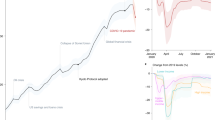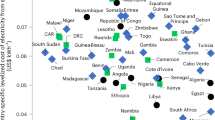Abstract
The production and use of fossil fuels need to decline rapidly to limit global warming. Although global net-zero scenarios abound, the associated development ramifications for fossil fuel-producing low and lower–middle income countries (LLMICs), as well as adequate international responses, have been underexplored. Here we conceptualize that, depending on country context, three types of development transition follow from declining fossil fuel production and use for LLMIC producers, namely an energy transition, an economic transition and an equitable fossil fuel production transition. We propose a classification of these transitions, arguing that heterogeneity in LLMICs’ fossil fuel production and usage substantially impacts their pathways towards low-carbon development. We illustrate this by discussing different cases of fossil fuel-producing LLMICs, focusing on Mozambique, India, Lao PDR and Angola. We conclude by detailing context-specific international support portfolios to foster low-carbon development in fossil fuel-producing LLMICs, and call for a re-orientation of international support along principles of global solidarity.
This is a preview of subscription content, access via your institution
Access options
Access Nature and 54 other Nature Portfolio journals
Get Nature+, our best-value online-access subscription
$29.99 / 30 days
cancel any time
Subscribe to this journal
Receive 12 digital issues and online access to articles
$119.00 per year
only $9.92 per issue
Buy this article
- Purchase on Springer Link
- Instant access to full article PDF
Prices may be subject to local taxes which are calculated during checkout



Similar content being viewed by others
References
Achakulwisut, P. et al. Global fossil fuel reduction pathways under different climate mitigation strategies and ambitions. Nat. Commun. 14, 5425 (2023).
Welsby, D., Price, J., Pye, S. & Ekins, P. Unextractable fossil fuels in a 1.5 °C world. Nature 597, 230–234 (2021).
Bouckaert, S. et al. Net Zero by 2050—A Roadmap for the Global Energy Sector (IEA, 2021); https://www.iea.org/reports/net-zero-by-2050 (2021).
UNFCCC. First global stocktake (United Nations, 2023); https://unfccc.int/sites/default/files/resource/cma2023_L17_adv.pdf
US Energy Information Administration. International Energy Data (US EIA, 2023); https://www.eia.gov/international/data/world
Erickson, P., Lazarus, M. & Piggot, G. Limiting fossil fuel production as the next big step in climate policy. Nat. Clim. Chang. 8, 1037–1043 (2018).
World Development Indicators (The World Bank Group, 2023); https://datatopics.worldbank.org/world-development-indicators/
UN DESA. Transforming our World: the 2030 Agenda for Sustainable Development (United Nations, 2015); https://sdgs.un.org/2030agenda
Saha, C. K. & Carter, A. V. Phase-out or lock-in fossil fuels? Least developed countries’ burning dilemma. Extr. Ind. Soc. 11, 101140 (2022).
UNFCCC. Party Groupings (United Nations, 2023); https://unfccc.int/process-and-meetings/parties-non-party-stakeholders/parties/party-groupings
Mulugetta, Y. et al. Africa needs context-relevant evidence to shape its clean energy future. Nat. Energy 7, 1015–1022 (2022).
SEI, IISD, ODI, E3G and UNEP. The Production Gap Report: 2020 Special Report (United Nations Environment Programme, 2020); https://productiongap.org/2020report
Hege, E. et al. Just Energy Transitions in the Context of Africa-Europe Relations (IDDRI, 2022); https://www.iddri.org/sites/default/files/PDF/Publications/CatalogueIddri/Rapport/Ukama_Synthesis_v02.pdf
Muttitt, G. & Kartha, S. Equity, climate justice and fossil fuel extraction: principles for a managed phase out. Clim. Policy 20, 1024–1042 (2020).
Andres, P., Mealy, P., Handler, N. & Fankhauser, S. Stranded nations? Transition risks and opportunities towards a clean economy. Environ. Res. Lett. 18, 45004 (2023).
African Economic Outlook 2022 (African Development Bank Group, 2022); https://www.afdb.org/en/documents/african-economic-outlook-2022
National Power Development Strategy (Lao Ministry of Energy and Mines, 2021).
Sterl, S., Fadly, D., Liersch, S., Koch, H. & Thiery, W. Linking solar and wind power in eastern Africa with operation of the Grand Ethiopian Renaissance Dam. Nat. Energy 6, 407–418 (2021).
Leader Associates. Scaling up rooftop solar in Vietnam —more than 9GW installed in 2020. pv magazine (2021); https://www.pv-magazine.com/press-releases/scaling-up-rooftop-solar-in-vietnam-more-than-9gw-installed-in-2020/
Gaventa, J. The Failure of ‘Gas for Development’—Mozambique Case Study (E3G, 2021); https://www.e3g.org/wp-content/uploads/Gas-for-development-Mozambique-case-study-December-2021.pdf
Mercure, J.-F. et al. Reframing incentives for climate policy action. Nat. Energy 6, 1133–1143 (2021).
Damodaran, A. Country Default Spreads and Risk Premiums (SSRN, 2023); https://pages.stern.nyu.edu/~adamodar/New_Home_Page/datafile/ctryprem.html
Alova, G., Trotter, P. A. & Money, A. A machine-learning approach to predicting Africa’s electricity mix based on planned power plants and their chances of success. Nat. Energy 6, 158–166 (2021).
Jain, A. K. Energy security is balancing of green thrust, fossil fuels. Energyworld (2022); https://energy.economictimes.indiatimes.com/news/renewable/energy-security-is-balancing-of-green-thrust-fossil-fuels/94749319
Sinha, S. Why India is the new hotspot for renewable energy investors. World Economic Forum (14 January 2020); https://www.weforum.org/agenda/2020/01/india-new-hotspot-renewable-energy-investors/
Renewable Power Generation Costs in 2020 (International Renewable Energy Agency, 2021); https://www.irena.org/publications/2021/Jun/Renewable-Power-Costs-in-2020
Powell, L., Sati, A. & Tomar, V. K. Coal Pricing in India: the High Cost of Low Prices (Observer Research Foundation, 8 August 2022).
Pai, S. & Zerriffi, H. A novel dataset for analysing sub-national socioeconomic developments in the Indian coal industry. IOP SciNotes 2, 14001 (2021).
Pai, S., Zerriffi, H., Jewell, J. & Pathak, J. Solar has greater techno-economic resource suitability than wind for replacing coal mining jobs. Environ. Res. Lett. 15, 34065 (2020).
Villavicencio-Calzadilla, P. & Mauger, R. in Dilemmas of Energy Transitions in the Global South (eds Kumar, A. et al.) 55–77 (Routledge, 2021).
Trotter, P. A. et al. How climate policies can translate to tangible change: evidence from eleven low- and lower-middle income countries. J. Clean. Prod. 346, 131014 (2022).
Sachs, J. D. & Warner, A. M. The curse of natural resources. Eur. Econ. Rev. 45, 827–838 (2001).
Marcon Nora, G. A., Alberton, A. & Ayala, D. H. F. Stakeholder theory and actor‐network theory: the stakeholder engagement in energy transitions. Bus. Strateg. Environ. 32, 673–685 (2023).
Naran, B. et al. Global Landscape of Climate Finance: A Decade of Data 2011–2020 (Climate Policy Initiative, 2022).
IDFC Green Finance Mapping Report 2021 (International Development Finance Club, 2021); https://www.idfc.org/wp-content/uploads/2021/11/idfc-gfm2021-full-report-final.pdf
Bradley, S., Lahn, G. & Pye, S. Carbon Risk and Resilience (Chatham House, 2018).
Cadot, O., Fernandes, A., Gourdon, J., Mattoo, A. & De Melo, J. Evaluating Aid for Trade: A Survey of Recent Studies. World Bank Policy Research Working Paper no. 6742 (World Bank 2014).
Stanley, M. C. et al. Managing Coal Mine Closure: Achieving a Just Transition for All (World Bank Group, 2018).
The Changing Wealth of Nations 2021 (The World Bank Group, 2022); https://datacatalog.worldbank.org/search/dataset/0042066
Global Oil and Gas Extraction Tracker (Global Energy Monitor, 2023); https://globalenergymonitor.org/projects/global-oil-gas-extraction-tracker/
Muggeridge, A. et al. Recovery rates, enhanced oil recovery and technological limits. Philos. Trans. A Math. Phys. Eng. Sci. 372, 20120320 (2014).
The Utilization Rate of National Industrial Capacity in the Third Quarter of 2022 (National Bureau of Statistics of China, 2022); http://www.stats.gov.cn/english/PressRelease/202210/t20221025_1889687.html
Committee on Coal Research Technology and Resource Assessments to Inform Energy Policy, Board on Earth Sciences and Resources, Division on Earth and Life Studies & National Research Council. Coal: Research and Development to Support National Energy Policy. Coal: Research and Development to Support National Energy Policy (National Academies Press, 2007); https://doi.org/10.17226/11977
Hauenstein, C. Stranded assets and early closures in global coal mining under 1.5 °C. Environ. Res. Lett. 18, 024021 (2023).
RISE—Regulatory Indicators for Sustainable Energy (The World Bank Group, 2022); https://rise.esmap.org/
World Bank Global Energy Data Catalogue (The World Bank Group, 2023); https://datacatalog.worldbank.org/home
Public Finances in Modern History (IMF, 2023); https://www.imf.org/external/datamapper/exp@FPP/USA/FRA/JPN/GBR/SWE/ESP/ITA/ZAF/IND
Sovereign Wealth Fund Rankings (Sovereign Wealth Fund Institute, 2022); https://www.swfinstitute.org/fund-rankings/sovereign-wealth-fund
World Ports by Country (World Port Source, 2023); http://www.worldportsource.com/countries.php
Economic Complexity Country Ranking (The Observatory of Economic Complexity (OEC), 2023); https://oec.world/
Acknowledgements
This work was partially funded by the Climate Compatible Growth programme of the UK government. The views expressed here do not necessarily reflect the UK government’s official policies.
Author information
Authors and Affiliations
Corresponding authors
Ethics declarations
Competing interests
The authors declare no competing interests.
Peer review
Peer review information
Nature Energy thanks Mark M. Akrofi, Maria Movsessian and the other, anonymous, reviewer(s) for their contribution to the peer review of this Work.
Additional information
Publisher’s note Springer Nature remains neutral with regard to jurisdictional claims in published maps and institutional affiliations.
Rights and permissions
Springer Nature or its licensor (e.g. a society or other partner) holds exclusive rights to this article under a publishing agreement with the author(s) or other rightsholder(s); author self-archiving of the accepted manuscript version of this article is solely governed by the terms of such publishing agreement and applicable law.
About this article
Cite this article
Foster, V., Trotter, P.A., Werner, S. et al. Development transitions for fossil fuel-producing low and lower–middle income countries in a carbon-constrained world. Nat Energy 9, 242–250 (2024). https://doi.org/10.1038/s41560-023-01440-3
Received:
Accepted:
Published:
Issue Date:
DOI: https://doi.org/10.1038/s41560-023-01440-3



